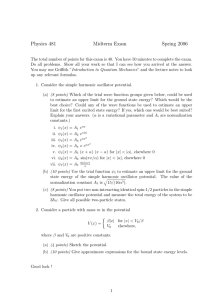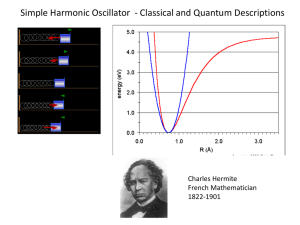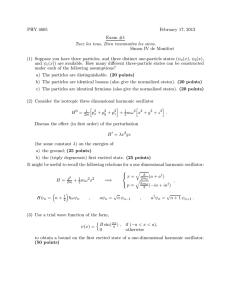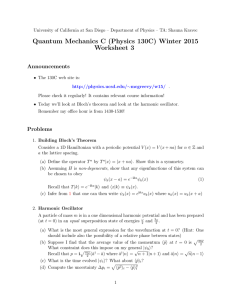5.61 Fall 2013 Problem Set #5 Suggested Reading: McQuarrie, Pages 396-409
advertisement
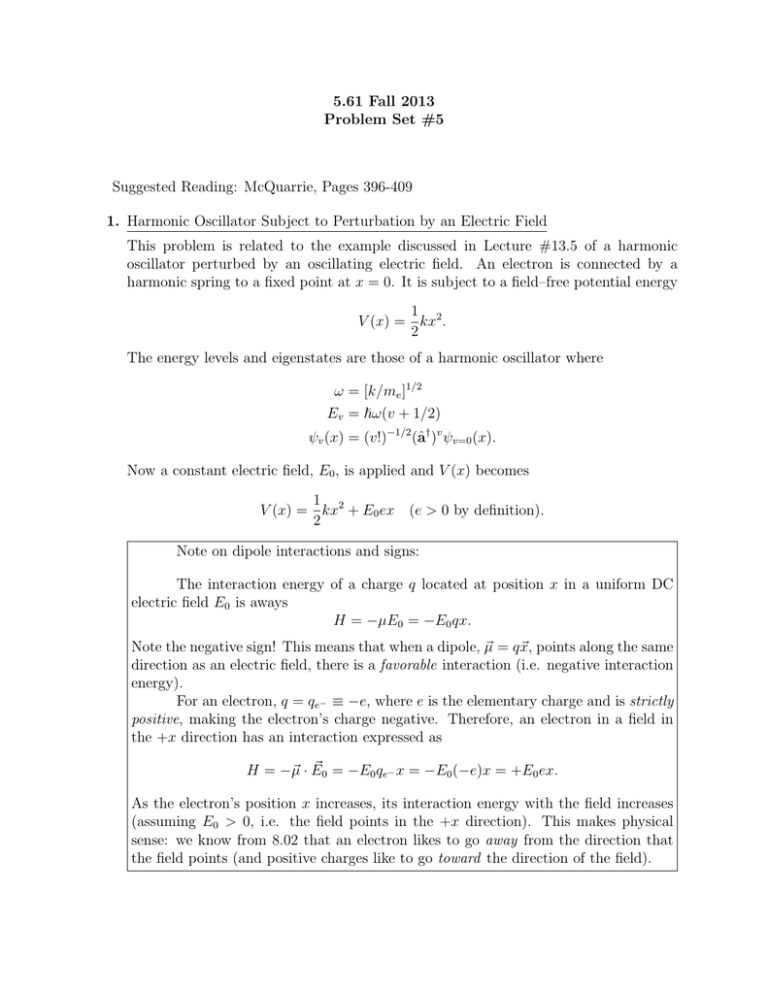
5.61 Fall 2013
Problem Set #5
Suggested Reading: McQuarrie, Pages 396-409
1. Harmonic Oscillator Subject to Perturbation by an Electric Field
This problem is related to the example discussed in Lecture #13.5 of a harmonic
oscillator perturbed by an oscillating electric field. An electron is connected by a
harmonic spring to a fixed point at x = 0. It is subject to a field–free potential energy
1
V (x) = kx2 .
2
The energy levels and eigenstates are those of a harmonic oscillator where
ω = [k/me ]1/2
Ev = }ω(v + 1/2)
ψv (x) = (v!)−1/2 (↠)v ψv=0 (x).
Now a constant electric field, E0 , is applied and V (x) becomes
1
V (x) = kx2 + E0 ex (e > 0 by definition).
2
Note on dipole interactions and signs:
The interaction energy of a charge q located at position x in a uniform DC
electric field E0 is aways
H = −µE0 = −E0 qx.
Note the negative sign! This means that when a dipole, µ
~ = q~x, points along the same
direction as an electric field, there is a favorable interaction (i.e. negative interaction
energy).
For an electron, q = qe− ≡ −e, where e is the elementary charge and is strictly
positive, making the electron’s charge negative. Therefore, an electron in a field in
the +x direction has an interaction expressed as
~ 0 = −E0 qe− x = −E0 (−e)x = +E0 ex.
H = −~µ · E
As the electron’s position x increases, its interaction energy with the field increases
(assuming E0 > 0, i.e. the field points in the +x direction). This makes physical
sense: we know from 8.02 that an electron likes to go away from the direction that
the field points (and positive charges like to go toward the direction of the field).
You are going to approach this problem two ways:
(i) by a simple and exact way first, and then
(ii) by perturbation theory.
A. Solve for xmin , V (xmin ), and V (x0 ) where x0 = x − xmin for this harmonic oscillator
in a constant electric field. Is the system still a harmonic oscillator? What is ω
for this oscillator?
B. Write an expression for the energy levels as a function of the strength of the
electric field.
C. One definition of the polarizability, α, is the second derivative of the energy with
respect to the electric field
d2 E v
.
αv = −
dE02
What is the value of αv ? Is it v–dependent?
D. Another definition of the polarizability is
µ(E0 ) − µ(E = 0) = αE0
where µ is the electric dipole moment. Using this definition of α, what is µ(E0 )?
E. Now let’s approach this problem by perturbation theory. The zero-order energies
and wavefunctions are those of the harmonic oscillator at E0 = 0. The perturbation term is
b (1) = E0 ex̂
H
where x̂ is the usual harmonic oscillator displacement coordinate. If
x̂ =
}
2µω
1/2
(â + ↠),
write a general formula for all of the non-zero
Z
xv0 ,v ≡ dxψv?0 xψ
ˆ v
integrals.
b (1)
F. Using the value you found for xv0 ,v write all of the E0 –dependent values for H
v 0 ,v
and then compute the energy levels of the harmonic oscillator perturbed by a
electric field, where
Ev = Ev(0) + Ev(1) + Ev(2)
and the perturbed wavefunctions are
ψv = ψv(0) + ψv(1) .
5.61 Problem Set #5
Fall, 2013
Page 2
d2 E v
compute the polarizability, αv . Is the polarizability v–dependent?
dE02
Does αv agree with the value you obtained in part C?
n
o
(1)
H. Using the ψv , compute µv using
G. Using
Z
µv = e
dxψv? xψ
ˆ v
where the ψv here are the perturbed ψv . Is µ v–dependent? Should it be v–
dependent? Does it agree with the result you obtained in part D?
2. Perturbation Theory for a Particle in a modified infinite box
b (0) = p̂2 /2m + V (0) (x)
H
V (0) (x) = ∞
V
(0)
x < 0, x > a
0≤x≤a
(x) = 0
b (1) = V 0 (x)
H
V 0 (x) = 0
a+b
a−b
,x >
2
2
a+b
a−b
<x<
, V0 > 0
2
2
x<
V 0 (x) = −V0
where a > 0, b > 0, and a > b.
A. Draw V (0) (x) + V 0 (x).
(0)
(0)
B. What are ψn (x) and En ?
C. What is the selection rule for non-zero integrals
Z
(1)
b (1) ψ (0) ?
Hnm = dxψn(0) H
m
D. Use
sin A sin B =
and
1
[cos(A − B) − cos(A + B)]
2
Z
dx cos Cx =
(0)
(1)
1
sin Cx
C
(2)
to compute En = En + En + En for n = 0, 1, 2, and 3 and limiting the
second-order perturbation sums to n ≤ 5.
E. Now reverse the sign of V0 and compare the energies of the n = 0, 1, 2, 3 levels
for V0 > 0 vs. V0 < 0.
5.61 Problem Set #5
Fall, 2013
Page 3
3. Perturbation Theory for Harmonic Oscillator Tunneling Through a δ–function Barrier
V (x) = (k/2)x2 + Cδ(x)
(1)
where C > 0 for a barrier. δ(x) is a special, infinitely narrow, infinitely tall function
centered at x = 0. It has the convenient property that
Z ∞
δ(x)ψv (x)dx = ψv (0)
(2)
−∞
where ψv (0) is the value at x = 0 of the v th eigenfunction for the harmonic oscillator.
Note that, for all v = odd,
Z ∞
δ(x)ψodd (x)dx = 0
(3)
−∞
A. (i) The {ψv } are normalized in the sense
Z ∞
|ψv |2 dx = 1
(4)
−∞
What are the units of ψ(x)?
(ii) From Eq. (2), what are the units of δ(x)?
(iii) V (x) has units of energy. From Eq. (1), what are the units of the constant,
C?
B. In order to employ perturbation theory, you need to know the values of all integrals
b (1)
of H
b (1) ≡ Cδ(x)
H
Z
(5)
+∞
b (1) ψv (x)dx = Cψv0 (0)ψv (0)
ψv0 (x)H
(6)
−∞
b (0) ψv (x) = }ω(v + 1/2)ψv (x).
H
(1)
(7)
(2)
Write general formulas for Ev and Ev (do not yet attempt to evaluate ψv (0)
for all even–v). Use the definitions in Eqs. (8) and (9).
(1)
Ev(1) = Hvv
(8)
Ev(2)
=
(1)
2
X
Hvv0
v 0 6=v
Ev − E v 0
(0)
(0)
(9)
C. The semi-classical amplitude of ψ(x) is proportional to [vclassical (x)]−1/2 where
vclassical (x) is the classical mechanical velocity at x
vclassical (x) = pclassical (x)/µ =
5.61 Problem Set #5
1
[2µ(Ev − V (x))]1/2 .
µ
Fall, 2013
(10)
Page 4
h
i1/2
At x = 0, vclassical (0) = 2}ω(v+1/2)
. The proportionality constant for ψ(x) is
µ
obtained from the ratio of the time it takes to move from x to x + dx to the time
it takes to go from x− (Ev ) to x+ (Ev ).
dx/vclassical (0)
τv /2
2dx
2ωdx
=
=
vclassical (0)(h/}ω)
2πvclassical (0)
1/2
(ω/π)
ψv (0) ≈
for even-v
vclassical (0)
ψ(0)2 dx =
(1)
Use this semi-classical evaluation of ψv (0) to estimate the dependence of Hvv and
(2)
Hvv0 on the vibrational quantum numbers, v and v 0 .
D. Make the assumption that all terms in the sum over v 0 (Eq. (9)) except the v, v +2
(0)
(1)
(2)
and v, v − 2 terms are negligibly small. Determine Ev = Ev + Ev + Ev and
comment on the qualitative form of the vibrational energy level diagram. Are the
(0)
odd–v levels shifted at all from their Ev values? Are the even–v levels shifted up
(0)
or down relative to Ev ? How does the size of the shift depend on the vibrational
quantum number?
E. Estimate E1 − E0 and E3 − E2 . Is the effect of the δ–function barrier on the level
pattern increasing or decreasing with v?
F. Sketch (freehand) Ψ(x, t = 0) = 2−1/2 [ψ0 (x) + ψ1 (x)]. Predict the qualitative
behavior of Ψ? (x, t)Ψ(x, t).
G. Compute hx̂it for the coherent superposition state in part F. Recall that
Z
xv+1,v = (some known constants) ψv+1 (â + ↠)ψv dx.
H. Discuss what you expect for the qualitative behavior of hx̂it for the v = 0, 1
superposition vs. that of the v = 2, 3 superposition state. How will the right↔left
tunneling rate depend on the value of C?
4. Anharmonic Oscillator
The potential energy curves for most stretching vibrations have a form similar to a
Morse potential
VM (x) = D[1 − e−βx ]2 = D[1 − 2e−βx + e−2βx ].
Expand in a power series
7 4 4
VM (x) = D β x − β x + β x + . . . .
12
2 2
3 3
In contrast, most bending vibrations have an approximately quartic form
1
VQ (x) = kx2 + ax4 .
2
5.61 Problem Set #5
Fall, 2013
Page 5
Here is some useful information:
3/2
}
3
x̂ =
(â + ↠)3
2µω
2
}
4
x̂ =
(â + ↠)4
2µω
ω = (k/µ)1/2
(k/µ)1/2
2πc
† 3
3
b + 1)â + 3N
b ↠+ â†3
(â + â ) = â + 3(N
b − 2] + [6N
b 2 + 6N
b + 3] + â†2 (4N
b + 6) + â†4
(â + ↠)4 = â4 + â2 [4N
b = ↠â.
N
ω
e=
The power series expansion of the vibrational energy levels is
Ev = hc ω(v
e + 1/2) − ωx̃(v
e
+ 1/2)2 + ωỹ(v
e
+ 1/2)3 .
A. For a Morse potential, use perturbation theory to obtain the relationships between (D, β) and (ω
e , ωx̃,
e ωỹ).
e
Treat the (â + ↠)3 term through second–order
perturbation theory and the (â + ↠)4 term only through first order perturbation
theory.
[HINT: you will find that ω
e ỹ = 0.]
B. Optional Problem
For a quartic potential, find the relationship between (ω,
e ωx̃,
e ωỹ)
e and (k, b) by
† 4
treating (â + â ) through second–order perturbation theory.
5. Phase Ambiguity
b operators to generate all Harmonic Oscillator wavefunctions
When one uses â, ↠and N
and calculate all integrals, it is easy to forget what the explicit functional forms are
for all of the ψv (x). In particular, is the innermost
(near
x− ) or outermost (near x+ )
†
−1/2 b
b
lobe of the ψv always positive? Use â = 2
x̃ − i p̃ to show that the outermost
lobe of all ψv (x) is always positive, given that
ψv (x) = [v!]−1/2 (↠)v ψ0 (x)
and that ψ0 (x) is a positive Gaussian. Apply x̂ and −ip̂ to the region of ψ0 (x) near
x+ (E0 ) to discover whether the region of ψ1 (x) near x+ (E1 ) is positive or negative.
5.61 Problem Set #5
Fall, 2013
Page 6
MIT OpenCourseWare
http://ocw.mit.edu
5.61 Physical Chemistry
Fall 2013
For information about citing these materials or our Terms of Use, visit: http://ocw.mit.edu/terms.



